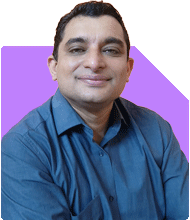Why Am I Feeling Extremely Sleepy After Starting My Workout Routine?
Dr Chandrakant Lahariya | Answer |Ask -Follow
Diabetologist, Consultant Physician, Vaccine Expert - Answered on Oct 30, 2024
The Delhi-based senior physician also has over 20 years of experience in hypertension, thyroid disorders and respiratory illnesses.
An expert on common health issues and the preventive aspects of medicine, he has co-authored the book, Till We Win: India's Fight Against The Covid-19 Pandemic.
Dr Chandrakant completed his MBBS from the Maulana Azad Medical College, New Delhi, and his MD from the Lady Hardinge Medical College, New Delhi.
He has a DNB (National Board of Examination, 2009) certification and a diploma in vaccinology from Institut Pasteur, Paris.... more

Hello Dr... I am 46 years old moderately built with a weight of 92 kgs, 5' 11", and a waist size of 40 inches (slightly obese). No Diabetes, BP, or any other lifestyle diseases. Slightly higher levels of LDL and good HDL. I have a history of CVT and I have been on warfarin for 12 years and my PT INR levels are between 1.8 to 2. I am a vegetarian with discipline in eating at the right intervals - 8 am, 1 pm, and 6:30 pm daily. I am moderately alcoholic once a month with a couple of beers or any hot drink with a limit of 2 drinks only during gatherings or parties. I am trying to lose weight and from last month, I started doing warmup exercises in the early morning for 45 mins along with Suryanamaskars and Pranayam (for which I had taken training during my childhood. In the evening I walk for 30-40 min 2.5-3.5 km. My problem is that after started working out since one month, I feel extremely sleepy between 1:30 to 2:30 pm (after lunch and take a nap of 15 min). And again I feel extremely sleepy between 5:30 to 6:30 which is forcing me to take a nap for 15-20 min. Both the times I get into sound sleep and snore as my wife complains. Night I go to bed at 10:30 and get up at early morning 4:45 but do not snore. Is this related to any underlying health issues that I need to get tested?
1. Please increase your night sleep time to around 7 to 8 hours.
2. Consult a dietitian to work on reducing weight.
3. There should not be any reason that you have day time snoring but not in night time. It might be linked to day time sleeping posture. However, in general people who are obese more likely to snore. You can consult a sleep medicine specialist to get this worked out.
4. Eat fruits and vegetables in the diet. Vitamin D, B12 and E supplementation for shorter duration may help you in feeling revitalised, provided you may have deficiency.
Best,
Dr Chandrakant Lahariya
Centre for Health: The Specialty Practice
Safdarjung Enclave, New Delhi
You may like to see similar questions and answers below
Roopashree Sharma | Answer |Ask -Follow
Yoga, Naturopathy Expert - Answered on Mar 30, 2023
Dr Shakeeb Ahmed Khan | Answer |Ask -Follow
Physiotherapist - Answered on Mar 15, 2024
Dr Chandrakant Lahariya | Answer |Ask -Follow
Diabetologist, Consultant Physician, Vaccine Expert - Answered on Oct 24, 2024
Purshotam Lal |68 Answers |Ask -Follow
Financial Planner, MF and Insurance Expert - Answered on Dec 17, 2025
Ramalingam Kalirajan |10899 Answers |Ask -Follow
Mutual Funds, Financial Planning Expert - Answered on Dec 17, 2025
Ramalingam Kalirajan |10899 Answers |Ask -Follow
Mutual Funds, Financial Planning Expert - Answered on Dec 17, 2025
Ramalingam Kalirajan |10899 Answers |Ask -Follow
Mutual Funds, Financial Planning Expert - Answered on Dec 17, 2025
Ramalingam Kalirajan |10899 Answers |Ask -Follow
Mutual Funds, Financial Planning Expert - Answered on Dec 17, 2025
Ramalingam Kalirajan |10899 Answers |Ask -Follow
Mutual Funds, Financial Planning Expert - Answered on Dec 17, 2025
Mayank Chandel |2576 Answers |Ask -Follow
IIT-JEE, NEET-UG, SAT, CLAT, CA, CS Exam Expert - Answered on Dec 17, 2025
Radheshyam Zanwar |6747 Answers |Ask -Follow
MHT-CET, IIT-JEE, NEET-UG Expert - Answered on Dec 16, 2025
Shalini Singh |181 Answers |Ask -Follow
Dating Coach - Answered on Dec 16, 2025
Patrick Dsouza |1429 Answers |Ask -Follow
CAT, XAT, CMAT, CET Expert - Answered on Dec 16, 2025



























